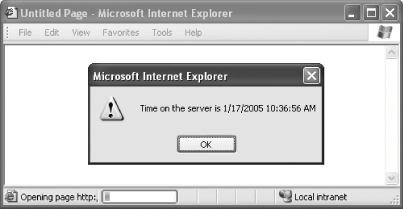Section 1.5. Insert Client Script into a Page
1.5. Insert Client Script into a PageThere are times when you need to insert client-side JavaScript into your page to implement client-side functionalities. Take the example of an eBanking web application. If the user has not been active for a certain period of time after logging in, the application will prompt the user with a pop-up window asking if the user would like to continue. Employing a pop-up window is more likely to draw the user's attention than simply displaying the message on the web page, and this is best implemented with client-side script. Note: You can now insert client script into your web page as naturally as writing your server-side code. In ASP.NET 2.0, you can insert client-side script by using the ClientScript property of the Page class. 1.5.1. How do I do that?To see how you can insert a client script into an ASP.NET 2.0 web application, you will create an application that displays the current time in a JavaScript window when the application is loaded.
1.5.2. What about......including a script file? Instead of inserting strings of client-side script into your application, you might have a much more sophisticated client-side application that is saved in a separate file. In this case, it is more effective for you to include the file directly rather than insert the scripts line by line. Suppose you have a script file saved as hello.js and its content contains JavaScript code (without the <script> tag): alert("Hello world, from JavaScript");You can include this script in your page through the RegisterScriptInclude( ) method: '--including script files Dim scriptURL As String = "./hello.js" Page.ClientScript.RegisterClientScriptInclude( _ Me.GetType, "MyKey", scriptURL) The generated output looks like this: <script src="/books/2/618/1/html/2/./hello.js" type="text/javascript"></script> 1.5.3. Where can I learn more?MSDN has a comprehensive article on injecting client-side script from an ASP.NET server control: http://msdn.microsoft.com/library/default.asp?url=/library/en-us/dnaspp/html/aspnet-injectclientsidesc.asp. |
